Across the US, yields of honey have been plummeting since the 1990s, leaving scientists and honey producers baffled. A new study has uncovered some clues regarding honey's mysterious lower levels.

Low Honey Production
The researchers used 50 years' worth of data from the US to analyze the possible mechanisms and factors that could affect the quantities of flowers that grow in different areas and, as an extension, the honey bees' honey. The data covered the average honey yield per honey bee colony, climate, weather anomalies, herbicide use, land use, and soil productivity within the continental US.
The study "Examining spatial and temporal drivers of pollinator nutritional resources: evidence from five decades of honey bee colony productivity data" discovered that honey yield changes over the year were linked to the application of herbicides and usage of land, including fewer specialized land conservation programs that are pollinator-supporting.
On top of this, annual anomalies in the weather were also found to affect yield changes.
Generally, the researchers discovered that soil productivity and climate conditions were among the most important considerations regarding honey yield estimations. States in cool and warm regions produced higher yields of honey when soils were productive.
Climate and Soil Conditions
Climate conditions, as well as eco-regional soil conditions, are the factors that set honey production baseline levels. On the other hand, weather, herbicide use, and land use changes affect honey production within a given year.
According to Gabriela Quinlan, the study's lead author and a postdoctoral research fellow of the National Science Foundation (NSF) in the Department of Entomology and Center for Pollinator Research at Penn State, the climate was increasingly linked to honey yields in the data coming after the year 1992.
Quinlan explains that it is unclear how climate change will keep impacting honey production. Nevertheless, the findings could help with the prediction of such changes.
Christina Grozinger, a co-author of the study and the director at the Center for Pollinator Research and a Publius Vergilius Maro Professor of Entomology explains that, though scientists already knew how various factors impact flowering plant abundance and production, earlier studies only focused on one US region.
Grozinger explains that what is unique about the study is that it maximized 50 years' worth of data coming from the continental US.
As noted by the researchers, one major pollinator stressor is the insufficiency of flowers to offer sufficient nectar and pollen for food. Since various regions may support different plants depending on the soil and climate characteristics, there is rising interest in noting landscapes and regions with sufficient flowers for bee friendliness.
Grozinger explains that several factors impact honey production, but a significant factor is flower availability.
On top of this, herbicide application rates were also crucial in honey yield predictions. This is potentially because removing flower weeds could decrease the nutritional sources available to bees.
Quinland explains that their findings offer crucial insights that could be used to enhance design experiments and models to help beekeepers predict yields of honey, growers know more about pollination services, and land managers support communities of plant pollination and ecosystem services.
RELATED ARTICLE : New Study Sheds Light on the Reproductive Lives of Honey Bees
Check out more news and information on Environment & Climate in Science Times.











